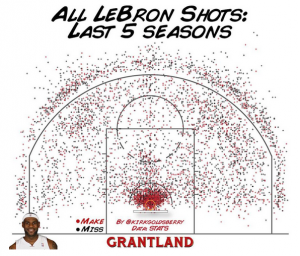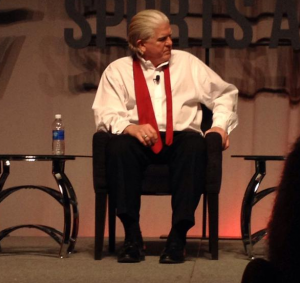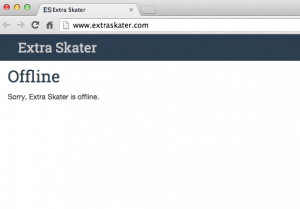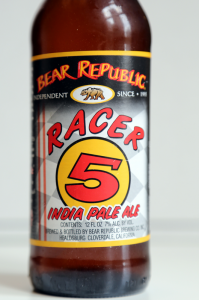Sloan 2015 – the stupidly long roundup – Part 2
Saturday at Sloan. Still cold? Oh yes. I’m publishing this final roundup post a week later and still have the chill in my bones.

Boston Common squirrels. Hardy fellas.
The Saturday schedule was a different animal for me. I wasn’t massively interested in any of the early talks so did the rounds of the hallways – that’s where most of the best stuff happens at Sloan anyway. Good chats about GPS, report automation, visualisation software,i and data collection for analysis of match officials.
By then it was late morning, and time to see the superstar of Sloan 2013ii: Kirk Goldsberry.
Analytics Illustrated, with Kirk Goldsberry
I like good visualisation. And some of the more interesting data visualisation in recent times has been done by Harvard professor and Grantland writer Kirk Goldsberry. His presentation was not at the level of Tufte but few are. It was, nonetheless, worthwhile.
Losing something from the game
“Anybody that wants to shoot a lot of threes needs somebody to create a lot of threes”, said Goldsberry. “I’m going to say that again”. And he did. James Harden was “Daryl’s perfect monster”, said Goldsberry. In a league becoming obsessed with the corner three, Harden had assisted the most corner threes in the NBA.
There’s a lot of people at Grantland who don’t like watching the Rockets play basketball, said Goldsberry. They think it’s ugly basketball. But it’s not the fault of the Rockets and those like them, he said, they should instead be blaming the NBA’s competition committee and the lines that they painted on the floot. It’s not the Rockets fault that a 24 foot shot is worth 50% more than a 22 foot shot. “It’s not their problem – these are the rules that they’re playing in”.
Goldsberry talked more than once about how important the Sloan conference had been for him. And that’s true. Yet he was obviously conflicted about the impact that analytics produced by both him and others across the basketball community was having on the game.
“Any league obsessed with three point shooting is going to have a casualty”. Players who are “pure basketball scorers” are being devalued, said Goldsberry. “The two-point areas between four and sixteen feet; highly defended court space where only truly skilled athletes can score offensively”. He thinks that the reduction of basketball scoring to particular areas of the court at the expense of mid-range shooting is very intelligent but as a fan of aesthetics he thinks basketball perhaps needs to give pause and ask what they might be losing from their game.
For me, this was the most interesting part of the hour. The conference that had been transformational in terms of his own life was spearheading a movement that was tearing a little hole in the game he loves.
You’ve got to love some inner torment.
Talking to an NBA great
“That’s some unique shit, man” – LeBron James’ response when Goldsberry presented him with a chart of every shot James had taken in the previous five years. The basketball great was just the second NBA player he’d ever talked toiii.

Credit: Grantland/Kirk Goldsberry
Is Scouting not Analytics?
“Does anybody else think scouts are analytics? I do” said Goldsberry. Somewhere there’s a scout sitting in an airport who knows more about the game of basketball than Goldsberry will ever know, he said. “And he’s spent years of his life generating reports and concocting reasoning artifactsiv – for his bosses – that support knowledge construction”.
Goldsberry talked of his frustration with the false framing of the “scouts vs stats” argument. “In social science… we talk about qualitative and quantitative social science. They’re both very acceptable forms of social science. In fact the best departments of geography or psychology or political science each have practitioners of qualitative or quantitative science working together on research. I would argue that scouts – maybe you could class them as qualitative social scientists, but they’re no less analytical than somebody who’s working in R or Excel”.
He said it was liberating to admit that you don’t know anything about basketball compared to any of these guys.
“They Know Things”.
Houston, we have a data problem
At the end an audience member about data access. As more and more data is being collected getting access to that is a big problem across all sports. “I couldn’t have picked a better question” said Goldsberry. “Facebook, AT&T, all these corporations have the best datasets in the world right now and they’re not exactly willing to share those. The NBA has its own version of this right now”. When Bill James and John Hollinger were doing their initial analysis “in the proverbial mom’s basement” they had access to pretty much the same data as the teams had in MLB and the NBA respectively, for the most part. There is now a paradigm shiftv. “I do think the NBA should do some soul-searching about its [data] access”. You don’t really need that much, he said. Just release a few monthsvi from 2012/13 and say “have at it, kids”.
“From a purely analytical point of view it’s one of the most frustrating things right now for the contemporary analytica community”.
He said the data access policies currently in place are suppressing the next generation of “bedroom analytics” and “rogue analysts”. The James’s and Hollingers of the world are not able to emerge from their mom’s basement, said Goldsberry.
Poets & Quants
A discussion about the use of analytics in sportswriting with some from the “new” and “old” schools.
“I devour everything that Bill Barnwell writes” said Peter King, he of the highly schmaltzy columns. This was a touch surprising to me. vii
King said that he grew up in Connecticut and read Peter Gammons’ news and notes column. He liked it a lot. That column formed the notion in King’s head of what was “good”. That’s what a good column looks like. And that’s where Monday Morning Quarterbackviii came from.
“You can not stat people into a coma”, said King.
Football Analytics
Brian Burke (the NFL one) made some really good points on this panel. About intent – what was a player being asked to do on that play? What was their technique supposed to be? Until you sit down with that player and spend time with them that’s a whole different part of your analysis of that player, said Burke.
“There’s just a deluge of data coming”, he said. But he said it’s going to be years down the road before he could program some algorithm to tell him something that couldn’t be learned from tape. It’s an interesting point where the NFL is concerned.
There’s only 11 minutes of action in a typical NFL game, said Burke. So if you’re a particular team’s defense coach that’s five or six minutes of action to watch. You could watch an entire game of your defense six times in a half an hour. And there’s only sixteen games [in the regular season] you could watch a single player’s complete season contribution in an hour and a halfix.
Less bang for the buck in NFL big data than other sports?
Perhaps.
Future of the Game
The other Brian Burke was at this one. The hockey one. And Nate Silver (FiveThirtyEight), Scott Pioli (Atlanta Falcons) and RC Buford (San Antonio Spurs).
Last panel of the weekend and, to be frank, a lot of them had been dry. High on generality, low on spice. And low on big names. And low on insight from the front. Silver said as much during the panel when he said you simply don’t have as much candour on the panels are you would have five or six years ago.
Burke sat on stage beside Nate Silver and played ornery, old-school grouch to Silver’s uber-nerd. Both were hamming it up a bit with some swearing thrown in. Proper swearing too.
When looking whether to sign a certain player their first step is not analytics but instead to see if that player will fit in with the team or the cityx, said Burke. And they don’t ever make a trade without consulting the head coach.
“You bring in a guy your coach hates you’re just giving yourself a bunch of headaches. There’d be a daily fight over this guy” said Burke. Why give yourself a daily fight when “you’ve probably already got one at home if you’re married”xi.

Brian Burke – the hockey one – on stage at the 2015 Sloan Sports Analytics Conference. Photo Credit: Twitter (@drjefflo)
Hockey under siege
Hockey is under siege, said Burke, due to the wariness about safety in youth sports. But also because of the difficulty of playing hockey as well as the expense involved in it. We’ve got to fix it, said Burke. What do you do to fix it, asked moderator Andrea Kramer.
“For example… if you want to build a [municipal] rink what’s the first thing you do? You hire an architect. Why? We should have those plans available to you, free of charge. You’d save a million bucks on design costs”.
“‘We’, the National Hockey League?” asked Kramer?
“We the National Hockey League, USA Hockey, Hockey Canada, whomever” said Burke. “They do this in Germany… if you want to build a rink they give you the designs”.
The safety issue is perceived as a major part of why ice hockey, like american football, is suffering from low participation numbers at the younger levels. But Burke thinks that there’s a bit too much shock and horror and what can be just a natural byproduct of the game.
“We play full contact sports and people seem horrified that we actually have injuries”, said Burke. “They’re not realising that the reason most of us chose those sports is because there was some level of violence in it”.
Burke said that he’d let a kid play whatever they want. Sure there’s a risk, sure there’s some danger but kids learn lessons playing sport, lessons they won’t learn anywhere else. “Your kid gets in a jam at school, what do they do? They look for a grown-up. We used to settle those things”.
“We play full contact sports and people seem horrified that we actually have injuries.
…
“They’re not realising that the reason most of us chose those sports is because there was some level of violence in it.”
– Brian Burke, Calgary Flames GM (NHL)
Bigger players? We need a bigger rink.
Everybody’s favourite grouchy panelist also talked about the need to increase the size of the NHL ice rink as players become bigger, faster, more powerful on a rink that was designed for play a century ago. This has obvious parallels to rugby union and I caught up with Burke, one of Rugby Canada’s board of directors, afterwards.
“I think we play on the same ice surface that we played on when we opened our doors for business a hundred years ago when the average size of a player was 5’8″ – 5’9″ and 160-170 pounds. And now the average size is 6’1.5″- 6’2″, 198 to 202 and that player is not just bigger, he’s much more muscular, much more powerful, much faster. So the actual playing surface has shrunk badly, because you have bigger, faster more solid people moving around at high rates of speed.”
What could be done to change this?
“I think we need to add five feet to the width of the rink. Maybe not today but over time as we bring new arenas online and I think we have to go to a 90 foot ice surface. Interestingly enough, in Finland in Helsinki the most recent rink that was built was a hybrid rink – it’s 91. They’re shrinking their rinks; they realise there’s not enough body contact on the Olympic sheet, so they’re shrinking their rink. I think we should move towards them.”
How long would this take? Burke said it “might take two decades but I figure, I’ve been at it for eight years to try to get it changed. I’m very persistent…”
“Your kid gets in a jam at school, what do they do? They look for a grown-up.
We used to settle those things”.
– Brian Burke, Calgary Flames GM (NHL)
Some Final Thoughts
It was great to see some Irish present at Sloan: Statsports, PocketCoach, Kitman Labs, Orreco. There were two gentlemen from the Danish Olympic team. Alan Hamilton was on the list from ice hockey’s Belfast Giants. It was disappointing, however, to see a general lack of attendance across rugby, cricket and (European) soccerxii. Very odd indeed to see no representative from Liverpool given their shared ownership with the analytically-driven Boston Red Sox.
Where are the Europeans?
Conference chair Jessica Gelman of the New England Patriots told me she hoped more European soccer teams would attend next year and that they’d had discussions with clubs in terms of presenting and even sponsoring.
But are smaller events, more focused in terms of content and more targeted in terms of being suited for practitioners, winning the battle for the “European” sports? Apart from the obvious geographic differences, should Sloan have a “World Sports” room? Somewhere for attendees from outside the US sporting universe to focus their attention and energy? A conference with 3000 people makes random meetings with people from a related sphere that much less likely to happen.
As I wrote in the Irish Times last week February’s OptaPro Forum in London had five attendees listed from Chelsea alone. November’s SportsData Performance event in Berlin had practitioners from across the sporting world – olympic sports, soccer, rugby – in an environment perhaps more suited to efficient networking and conversation. The Innovation Enterprise events attract a crowd too. And the Web Summit in Dublin started a Sports Summit for the first time last year.
Sports practitioners aside, it’s still surprising to me that there aren’t more from European sports business. It’s that kind of event now, where the balance is tipping ever more slightly away from the on-field stuff to off-field: ticketing analytics, fan engagement and the like.
Are the panels a victim of Sloan’s success?
The panels are drying up. Dry in terms of insight, candour and entertainment. While this year’s soccer panel was regarded by many I talked to as being better than those of the last couple of years, sports analytics has perhaps been a victim of its own success. Much of sport’s groundbreaking work is longer the preserve of the “rogue analysts” but is instead the property of various teams. While some of that is the data access issue that Goldsberry and his audience questioner addressed, another key component is the hoovering up of analytical talent by sports teams.
In MLB, the Baseball Prospectus website has been a good example of this. It has become an unofficial feeder team for MLB front offices, with BP “graduates” like Kevin Goldstein, Mike Fast and Jason Parks called up to the show. The basketball front offices of teams like the Rockets and 76ers will not be revealing their latest insights on a Sloan stage while they still regard that insight as part of their competitive advantage. In 2014 multiple amateur hockey analysts were taken on by NHL sides. When Darryl Metcalf was taken on by the Toronto Maple Leafs last Autumn his popular ExtraSkater.com website was taken downxiii.

All your ExtraSkater.com are belong to us. Kind Regards, Toronto Maple Leafs.
“Not only is his site one of the most respected in the hockey world”, wrote Yahoo’s Greg Wyshynski as news broke of Metcalf’s hiring, “it’s also one of the most popular … for other NHL teams. Our loss as hockey fans – the site will cease operation – is Toronto’s gain, as all of that site’s analysis and calculations will be kept in house”.
If, for the sake of argument, one accepts that we won’t get serious insight from Sloan panels then a couple of things might need to change. Here are my thoughts.
1. Bring in a second research stream. Of the various research proposals put forward at Sloan many are relegated to poster presentations. Quite literally, this is a large card-backed glossy poster sitting atop an easel. Give each of them twenty minutes to present it. Doesn’t have to be a big stage, something off to the side would be fine. There are LOTS of interesting people doing interesting sports research. There are journals dedicated to the stuff. A second research stream could easily be a very worthwhile addition.
2. That World Sports room I mentioned? Do that. Or something like it. And keep an eye on the balance of the attendees between practitioners/media/front office/students/others. Those useful chance meetings are a vital part of Sloan’s value.
3. For the big name panels, get names that are prepared to throw a few shots and take a few themselves. Brian Burke (hockey) and Nate Silver knew what they were there for: entertainment. I’m not looking for Jerry Springer. But I lost count of the number of times Charles Barkley was used as some sort of punchline, and the bottom line is that you need those folks there, in person. Healthy and informed skepticism is good.
4. Work out how, next year, researchers can compete with the papers that have access to proprietary league data. It’s an uneven playing field made worse when one considers the difficulty with recreating those results.
5. Oh, and the Data Visualisation stream? More of that. A very decent idea indeed.
Final, final thoughts

You should definitely try a Racer 5 IPA. They’ve pulled out of Massachussets because of the continuing drought in California, so explained the excellent and beer-centric barman at Lucky’s.
I nodded gravely and nursed a couple over some sliders.
If you see this IPA, pick up a bottle. Can’t recommend it more highly.
Related Reading: The Stupidly Long Sloan Roundup – Part 1


Comments
2 Responses to “Sloan 2015 – the stupidly long roundup – Part 2”Trackbacks
Check out what others are saying...[…] Next, Saturday. […]
[…] Sloan 2015 – the stupidly long roundup – Part 2 […]